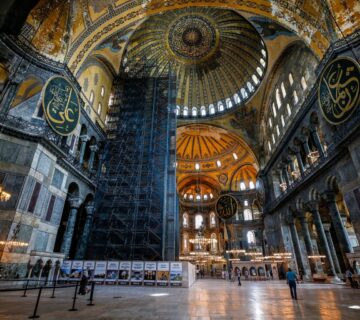Dr. Nadezhda Alexandrova is an associate professor at the Faculty of Slavic Studies at Sofia University “St. Kliment Ohridski”, Bulgaria. Her interests are focused on Ottoman and Balkan literature and culture from the 18th and the 19th c. Currently, she is a research fellow in the joint project entitled “How to teach Europe?”, funded by the Center of Advanced Studies in Sofia and New Europe College in Bucharest, She is working on an academic course about teaching history of emotions in Bulgarian and Balkan culture.
Playing video games on my mobile phone is not something I often do. Destroying bananas and lemons from a simple candy-crush-like-puzzle-game would be my top achievement while waiting for my plane at the airport. But last summer when the livin’ was easy I accidentally found a fascinating video game that plunged me into a regime of battles and conquests – Magnificent Sultans. Its plot followed roughly the times when the Ottomans invaded Southeastern Europe. Obviously it was just one of the commercial follow-ups from the big success story of the soap opera with a similar name – The Magnificent Century. For eight years it has attracted a multi thousands’ audience around the globe. While outside Turkey it clang to the spectators’ eyes with its Orientalist flavor of court intrigues, luxury and cruelty towards the unfaithful, in Turkey it was part of a more general trend for restoration of the heritage from the Ottoman times with both political, economic and cultural impact.
In fact not only in Turkey but also across the Balkans these new populist movements are on the rise, utilizing the repertoire of Orientalism to convey their present agenda to the public. In such times of evolving neonationalist rhetoric there is an image from this repertoire, which functions as a solid and ubiquitous signifier of foreign dominance – the Janissary. The processes of appropriation of this image by the Western imagination have been in place as early as the siege of Vienna (1529) and have continued to produce meaning after the end of the Janissary army (1826). The more time passed from the actual conquests and revolts of the Janissaries, the more abundant in capacity the metaphor has become. It contains the trauma of conversion to Islam that happened to the teenage boys, recruited predominantly from the Balkan provinces of the empire as a special form of taxation, known as a blood tax (devşirme). It also depicts the Janissaries as cruel soldiers, merciless to their former kin, and sometimes even to their master – the ruling sultan.
The metaphor had its impact on the process of nation-building of the Balkan nations in the 19th c. The ideology of romantic nationalism rigidified the figure of the Janissary as the evil convert, who signified backwardness, corruption and Islamophilia. But the latter religious aspect was not always necessarily brought under the spotlight when the notion of ‘the new Janissaries’ appeared. According to this notion of ‘the new Janissaries’ were not those who have converted to another religion but those who have been forcefully taken away from their families by a ruling political party to start a new life in a foreign (neighboring) territory. In the aftermath of the WWII this notion was reiterated in several occasions in the Balkans in relation to the displacement of population as result of the new national borders in the peninsula. Whereas in the 20th c. the foreign nation was the danger for inflicting such a “biological loss”, today the fear of losing the youth of the nation is enacted in cases when a certain international regulation is about to influence the local national agenda. The new populist rhetoric in the Balkans envisions transnational legal regulations and global markets as enemies to national sovereignty, while a warning against a form of “liberal Janissarism” is trumpeted.
And while in the former Ottoman territories the new populists detonate the fear of new Janissaries, in Turkey neo-Ottomanism is en vogue. The resurgent interest in the Ottoman past fueled both politics and popular media. The latter, despite its controversial representation of the historical facts of the life of the Sultans, globalizes the narrative of Turkey as a great power, and reiterates the image of the Janissary even in the realm of video games. The question is whether the products of global consumer culture, such as soap operas and video games are able to restrain populism and provoke knowledge-seeking in new audiences and generations, or rather the contrary, they can enhance its effects by means of modern media.
Days of glory and days of decline –history of the Janissaries
Similarly to a product lifecycle, the creation of the metaphor of the cruel Janissary has its outset, development and finale. There are three factors, which facilitated its making. These are the Orientalist historiography and literature, the Ottoman politics itself, and the communities in the Balkans that fought for their independence from the 18th to the early 20th c. All three factors are characterized by a mainstream historical narrative about this army, unfolding a story of initial military glory and subsequent moral decline. The glorious moments about the outset of the Janissary order start with the legend of Haci Bektaş who blessed the new soldiers (yeni çeri). It continues with the period of military success of the ruling Sultans between 15th and the end of the 17th c., for which his paid army of celibates, recruited usually from the non-Muslim population of the Balkan provinces of the empire played the main role. Later on the requirement of conversion, as well as that of celibacy, changed. The Janissaries grew in numbers counter proportionally to the success of the battles of the Ottoman Empire with its enemies.They revolted each time when the Sultans initiated military reforms that could threaten their position. They also joined gangs of criminals that supported the rivalry between the provincial governors. The abuse of power, which the Janissaries performed both in Istanbul and the provinces, was regarded as a signal for the moral decline of the corps, and the reason for their eventual dismantlement by the Sultan Mahmud II in 1826.
Certainly, the historians of the Ottoman period have questioned the simple narration of the purity-decline paradigm. They have proven that the facts about this army and the blood taxrecruitment practices are interwoven with orally transmitted legends and folksongs. The latter often blurred the factual residue of the main characters and historical events, replacing them with myths and fantasies. However, one feature remained intact: being a Janissary was a privileged social position and guaranteed a career in the Ottoman power structure. Regular payment, provision of food, lack of taxation, military training and skills in various crafts were some of the benefits of becoming a Janissary. Other benefits involved being part of the networks of protection over the various guilds that controlled trade and the distribution of goods. Some would say bluntly that those were the “mafia guys” of their time and explain their corrupted actions with their loss of initial home place, family and religious ties with Christianity.
Orientalism and the creation of the metaphor of the Janissary
Despite the fact that the historical lifecycle of the Janissary army ends in 1826, its figurative lifecycle continues way beyond this date. Both Ottoman historiography and the Western European one at the time express appraisals for the Sultans from the Tanzimat period who initiated numerous reforms to save the empire from falling apart. Besides historiography, the substantial contribution in the construction of the image of the cruel Janissary was made by the discourse of Western Orientalism, which depicted the East as a place of exoticism, eroticism, violence and religious fanatism. Various forms of expression of this discourse flourished in Europe, reaching a peak by the end of the 19th c. Mozart’s Rondo Alla Turka originated from Janissary drum music (mehter); Gentile Bellini, Melchior Lorck, Henry Bonnart and Jean Baptiste Van Moure’s paintings of Janissaries spread across Western Europe since the 15th c. onwards. Plenty of writers of popular novels wrote in 19thc. on the same topics. For instance, the Albanian national hero Skanderbeg was depicted in the novel The captain of the Janizaries (1890) by James Meeker Ludlow; the times of reformers Selim III and Mahmud II functioned as a historical setting for the novel Les janissaires by Alphonse Royer; the Hungarian writer Mor Jokai became world famous with his novel The Last Days of the Janissaries (1854), translated into English as The Lion of Janina (1897).
This list of Western Orientalist works can easily be enriched with more examples but what deserves attention for the situation in the Balkans is that the local intellectuals also took advantage of the craze about the Janissaries. They contributed to the process of building of their respective modern nations by writing about the struggle of the local communities against the cruel Janissaries. For instance the Bulgarian writer Vassil Drumev writes about the gangs of Janissaries and Kircalis in his famous novella Neshtastna familia (A tragic family – 1860); The Serbian writer Jakov Ignjatovic in his novel Mansur and Dzamila(1874) conveys to the readers a tragic interreligious love story; and the Greek writer Antonis Antoniadis is inspired by the motive of recognition of a Janissary by his own mother in his novel The mother of a janissary (1877). All these examples display the successful coining of the image of the janissary in the national literature of many of the new countries that appeared on the map of Europe during the last two centuries. Modern Balkan ethnography also contributed to this process by gathering corpora of “historical songs”, most of which deal with the drama of conversion. Usually the plot contains the motive of recognition and of incest – a Janissary and his beloved discover the dreadful secret of the past. By a sign or scar on the body of the beloved the Janissary recognizes his former sister or mother. Where historical data about separation, blood tax and the number of converted teenage boys was scarce, literature, art, ethnography, and later on film industry, added the necessary superpower so that the image of the janissary continued to evoke traumatic (and often invented) memories.
How can new Janissaries be born from gender devsirme?
In a recent article the French historian Bernar Lory retells a story that dates back to the time when Albania was under Italian occupation during the WWII. The Italians decided to send Albanian children to summer camps which caused suspicion and fear in their parents, weeping that Italians recruit “new Janissaries”. Thinking that she’d never see her son again, a mother with a visual disability gave her son her glass eye with the words: “If you see a woman with one eye of this color, you will know it is your mother”. In a similar fashion the children who were sent to the Socialist countries as a result of the Greek Civil War in the late 1940s were called “new Janissaries”. The examples can continue with the post-war situation in Serbia. In the year when the leader of the Serbian Radical Party Vojislav Šešelj was indicted by the Hague tribunal for “joint criminal enterprise” he wrote a book entitled Досманлије као нови јањичари (DOS-mans as new Janissaries – 2003). He criticizes the representatives of the Democratic Opposition of Serbia (DOS) as traitors to the country. All those cases from the past century display the steadiness of the metaphor of the Janissary. However, this time the enemy is not an empire, and religious conversion is not taking place. Rather, the nationalists from several Balkan countries endorsed the topic of endangered procreation by a drastic example with a long traumatic history. It was called the new Janissaries.
In a similar fashion contemporary populist and conservative movements in Bulgaria enacted the image of the new Janissaries. The first occasion when it happened was in 2018 when the populist and right-nationalist parties organized a campaign against the Convention on preventing and combating violence against women and domestic violence (a document of the Council of Europe, known as the Istanbul Convention). By a snowball effect of fake news, which was spread by means of traditional and social media, the populists managed to twist the meaning of gender in the text of the Convention to homosexuality. They actively spread public statements against the ratification of a convention, which seemingly spoke about third gender and gender ideology. The reason for non-ratification was simplified to a primal fear that this convention (that spoke of the prevention of violence) will open space for anyone to choose their gender, and eventually the traditional Bulgarian family and its capacity of procreation could he hampered. Bulgarians were heavily misled, the convention was not ratified and the victims of domestic violence had fewer chances for international legal support. From then on gender became a derogative word for gay, and the populists voices frenetically announced they have won the battle against gender devşirme.
More recently, at the beginning of 2019 another such disinformation campaign led to the obstruction of the discussions for the acceptance of the Project for National Strategy for Protection of Children 2019-2030. Representatives of leading religious denominations in Bulgaria, as well as neoconservative and populist parties, stood united in their claims against the document. Their motives were that it is diminishing the rights of the parents and that the state and the social services will be able to take away children from their families “based on the Norwegian model of child protection” and the much feared “juvenile justice” portrayed as a legal framework to endorse the model. In the marches, organized in several big Bulgarian cities, as well as in the social media, the phenomenon was called Norwegian Janissarism.
Both case studies from Bulgaria display that the new Janissaries is a metaphor, capable of huge mobilization of fear and anger against social reforms. They also indicate that the figure of the enemy is neither an empire, nor a modern nation. Nowadays, big predators are the transnational regulatory mechanisms that organizations such as the European Union or the United Nations have accepted in order to prevent cases of inequality, violence and abuse of human rights. It seems that the new Janissaries strike back at international institutions due to a globalization paradox, as Dani Roderick has called it. The new Janissaries in the repertoire of neo-nationalism are a weapon that aims at limiting globalization for the sake of keeping national sovereignty. Yet, the global market and transnational institutions are out there exactly because of the need of the nation-states to handle their internal financial stability and to secure democracy on a supra-national scale.
As a modern democratic nation today Turkey also is obliged to follow the international regulations. The country is not an exclusion from the wider tendency of rising populism, though. Rather than recalling the image of the Janissaries alone, it acknowledges them as a kind of heritage, equally fit for supporting populist claims, as well as national advertising for the sake of tourism. While in the other Balkan nations the populist voices instrumentalize image of the Ottoman soldiers to recall trauma and arise fear of a new invasion, in Turkey populism emphasizes the role of the Janissaries to the conquests of the Ottoman Empire during its days of glory. The process of rehabilitation of the Ottoman past in a post-Kemalist era is ongoing but as any country in the world this one also needs to negotiate between internal nationalistic concerns and transnational global markets.
Exports such as soap operas can illustrate this interdependency. The Magnificent Centurysolely has achieved 250 million spectators across five continents from 2014 to 2018. Despite the criticism to its genre and to the representation of the Sultans, coming even from the president Erdoğan himself, the series advertise contemporary Turkey as touristic destination and open up widely the international markets for such new products of popular culture as the TV series. Together with the video games in the same thematic vein, they leverage on the repertoire of Orientalism to profit from new audiences. The image of the Janissaries has grown quite vivid and remarkable again. Тhis time their army destroys fortresses and recruits new soldiers by means of 3D programming and montage. Can contemporary popular culture influence the rising populist and neo-nationalist movements? It seems the answer is positive, if we judge by the horrific cases of the recent terrorist attacks in Norway and in Christchurch, New Zealand. New waves of populism use as propaganda weapon the new Janissaries to recall old refrains of trauma and generate new forms of hostility.







